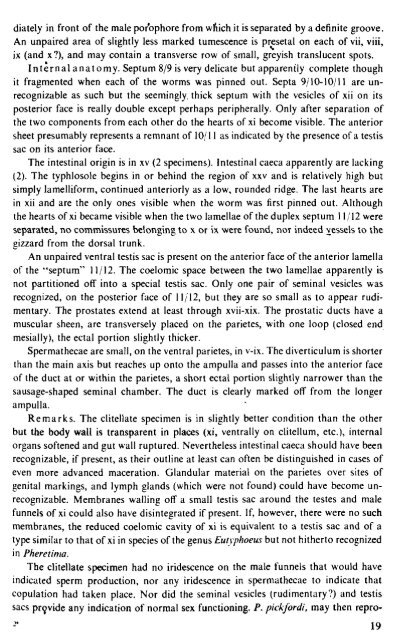Create successful ePaper yourself
Turn your PDF publications into a flip-book with our unique Google optimized e-Paper software.
diately in front of the male por'ophore from wl1ich it is separated by a definite groove.An unpaired area of slightly less marked tumescence is presetal on each of vii, viii,..ix (and x ?), and may contain a transverse row of small, greyish translucent spots.Internal anatomy. Septum 8/9 is very delicate but apparently complete thoughit fragmented when each of the worms was pinned out. Septa 9/10-10/11 are unrecognizableas such but the seemingly. thick septum with the vesicles of xii on itsposterior face is really double except perhaps peripherally. Only after separation ofthe two components from each other do the hearts of xi become visible. The anteriorsheet presumably represents a remnant of 10/ II as indicated by the presence of a testissac on its anterior face.The intestinal origin is in xv (2 specimens). Intestinal caeca apparently are lacking(2). The typhlosole begins in or behind the region of xxv and is relatively high butsimply Iamelliform, continued anteriorly as a low, rounded ridge. The last hearts arein xii and are the only ones visible when the worm was first pinned out. Althoughthe hearts of xi became visible when the two lamellae of the duplex septum 11/12 wereseparated, no commissures belonging to x or ill. were found, nor indeed yessels to thegizzard from the dorsal trunk.An unpaired ventral testis sac is present on the anterior face of the anterior lamellaof the "septum" 11/12. The coelomic space between the two lamellae apparently isnot partitioned off into a special testis sac. Only one pair of seminal vesicles wasrecognized, on the posterior face of II; 12, but they are so small as to appear rudimentary.The prostates extend at least through xvii-xix. The prostatic ducts have amuscular sheen, are transversely placed on the parietes, with one loop (closed endmesially), the ectal portion slightly thicker.Spermathecae are small, on the ventral parietes, in v-ix. The diverticulum is shorterthan the main axis but reaches up onto the ampulla and passes into the anterior faceof the duct at or within the parietes, a short ectal portion slightly narrower than thesausage-shaped seminal chamber. The duct is clearly marked off from the longerampulla.Remarks. The c1itellate specimen is in slightly better condition than the otherbut the body wall is transparent in places (xi, ventrally on clitellum, etc.), internalorgans softened and gut wall ruptured. Nevertheless intestinal caeca should have beenrecognizable, if present, as their outline at least can often be distinguished in cases ofeven more advanced maceration. Glandular material on the parietes over sites ofgenital markings, and lymph glands (which were not found) could have become unrecognizable.Membranes walling off a small testis sac around the testes and malefunnels of xi could also have disintegrated if present. If, however, there were no suchmembranes, the reduced coelomic cavity of xi is equivalent to a testis sac and of atype similar to that of xi in species of the genus Eutyphoeus but not hitherto recognizedin Pheretima.The clitellate specimen had no iridescence on the male funnels that would haveindicated sperm production, nor any iridescence in spermathecae to indicate thatcopulation had taken place. Nor did the seminal vesicles (rudimentary?) and testissacs pr\)vide any indication of normal sex functioning. P. pickfordi, may then repro-2'19
















